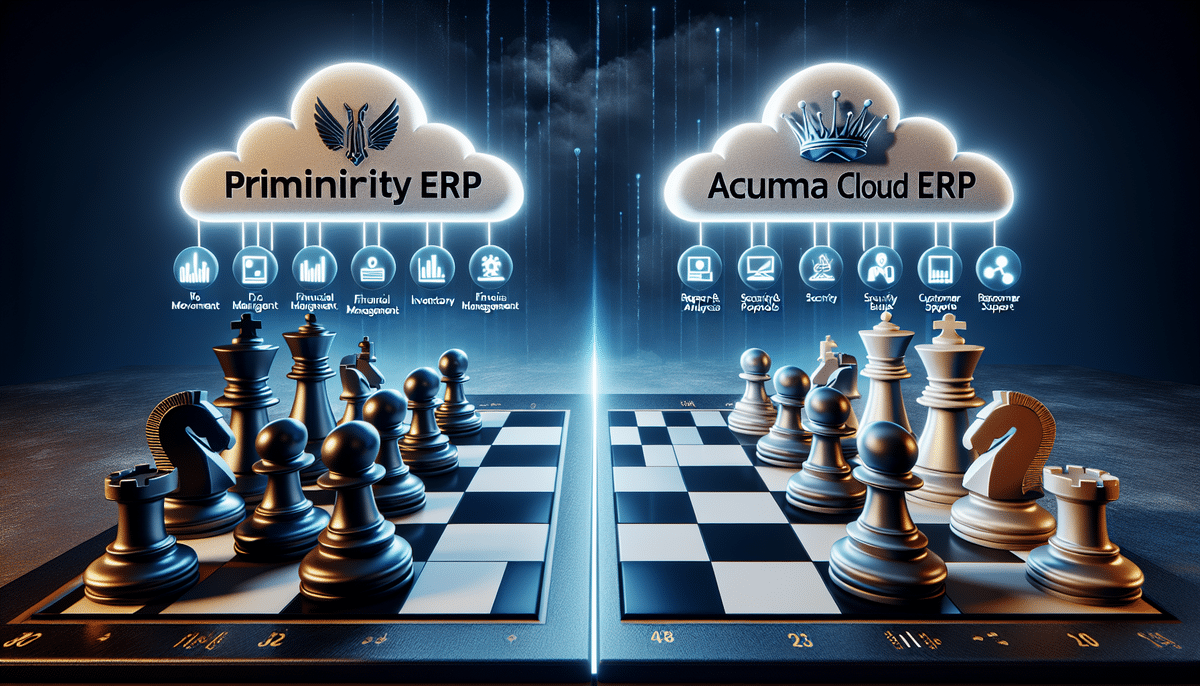Priority ERP vs Acumatica Cloud ERP: A Comprehensive Comparison
If you're in the market for an Enterprise Resource Planning (ERP) solution, you've likely encountered both Priority ERP and Acumatica Cloud ERP. While both platforms offer a range of features and functionalities, determining the best fit for your business's unique needs requires a thorough comparison. This article delves into the key differences between Priority ERP and Acumatica Cloud ERP, supported by data and insights to help you make an informed decision.
Understanding ERP and Cloud-Based Solutions
An ERP system is a comprehensive software application that assists businesses in managing various aspects of their operations, including finance, human resources, inventory management, and more. Cloud-based solutions are hosted on remote servers and accessed via the internet, offering enhanced flexibility and scalability compared to traditional on-premises systems.
According to a 2023 report by Gartner, the adoption of cloud-based ERP solutions has increased by 15% annually, driven by the need for greater agility and reduced IT overhead.
Key Features and Functionalities
Core Capabilities
- Financial Management
- Inventory Management
- Reporting and Analytics
Both Priority ERP and Acumatica Cloud ERP provide these core functionalities. However, their specialized features set them apart:
- Priority ERP is renowned for its extensive manufacturing and production capabilities, making it ideal for manufacturing-centric businesses.
- Acumatica Cloud ERP excels in multi-entity management and project accounting, catering to businesses with complex operational structures.
Customization and Flexibility
Customization is crucial for businesses with unique processes. Priority ERP offers extensive customization options, including custom workflows and report generation. In contrast, Acumatica Cloud ERP provides flexibility through its open APIs, allowing seamless integrations with third-party applications.
For more details on ERP customization, refer to this Forbes article on ERP customization.
Pricing Models and Cost Efficiency
Cost is a significant factor in ERP selection. Both Priority ERP and Acumatica Cloud ERP offer flexible pricing structures based on user count and required features.
Priority ERP typically follows a traditional licensing model, which may involve higher upfront costs but can be cost-effective in the long run for larger organizations.
Acumatica Cloud ERP offers a pay-per-use pricing model, which can be more economical for small to medium-sized businesses or those with variable usage patterns.
According to a Software Advice pricing guide, cloud-based ERP solutions like Acumatica often have lower initial costs and predictable ongoing expenses.
Implementation Process and Timeline
Implementation timelines vary based on the complexity of the business and the chosen ERP system.
- Priority ERP: Typically implemented within 4-6 months, suitable for businesses requiring extensive customization.
- Acumatica Cloud ERP: Can be deployed in as little as 6-12 weeks, ideal for organizations seeking a faster go-live timeline.
Efficient implementation is critical for minimizing disruption. A study by Nucleus Research highlights that Acumatica's cloud-based approach can reduce implementation time by up to 30% compared to traditional ERPs.
User Interface and User Experience
The user interface (UI) and overall user experience (UX) significantly impact employee adoption and productivity.
- Priority ERP features a traditional UI, which may cater to users accustomed to legacy systems.
- Acumatica Cloud ERP offers a modern, intuitive, web-based interface that enhances usability and accessibility across devices.
A Userlike blog emphasizes the importance of a user-friendly ERP UI in improving employee engagement and reducing training costs.
Security Measures and Data Protection
Data security is paramount in ERP systems, as they handle sensitive business information.
- Both Priority ERP and Acumatica Cloud ERP implement robust security protocols, including data encryption, user authentication, and regular security audits.
- Acumatica Cloud ERP benefits from cloud-specific security measures, such as automated backups and advanced threat detection.
The CSO Online highlights the enhanced security features inherent in cloud-based ERP solutions.
Customer Support and Service
Effective customer support ensures smooth ERP operations and quick resolution of issues.
- Priority ERP offers comprehensive support services, including phone and email assistance, detailed knowledge bases, and active user communities.
- Acumatica Cloud ERP provides 24/7 support, extensive online resources, and a vibrant user community to address diverse customer needs.
A G2 article on ERP software emphasizes the importance of responsive customer support in enhancing user satisfaction and retention.
Pros and Cons: Making the Right Choice
Evaluating the strengths and weaknesses of each ERP solution helps in making an informed decision:
- Priority ERP:
- Pros: Extensive manufacturing capabilities, robust customization options.
- Cons: Longer implementation time, traditional UI may require more training.
- Acumatica Cloud ERP:
- Pros: Fast implementation, modern interface, flexible pricing.
- Cons: Limited customization compared to Priority ERP, may require reliance on third-party integrations.
Factors to Consider Before Choosing an ERP Solution
Before selecting between Priority ERP and Acumatica Cloud ERP, assess the following factors:
- Business Complexity: Determine the complexity of your operations and the need for specialized modules.
- Scalability: Ensure the ERP can scale with your business growth.
- Budget: Consider both upfront costs and ongoing expenses.
- Customization and Integration Needs: Evaluate the extent of customization and integration with existing systems.
- Implementation Timeline: Align the ERP implementation timeline with your business objectives.
- User Adoption: Assess the ease of use and training requirements to ensure high user adoption rates.
For a deeper understanding, refer to this Datamation ERP selection guide.
Conclusion: Choosing the Best ERP for Your Business
Selecting the right ERP solution is a critical decision that impacts your business's efficiency and growth. Both Priority ERP and Acumatica Cloud ERP offer robust features tailored to different business needs. Priority ERP is ideal for manufacturing-centric organizations requiring extensive customization, while Acumatica Cloud ERP suits businesses seeking flexibility, faster implementation, and modern user experiences.
To make the best choice, thoroughly assess your business requirements, budget constraints, and long-term objectives. Leveraging reputable resources and possibly consulting with ERP experts can further aid in selecting the ERP system that aligns with your strategic goals.






















